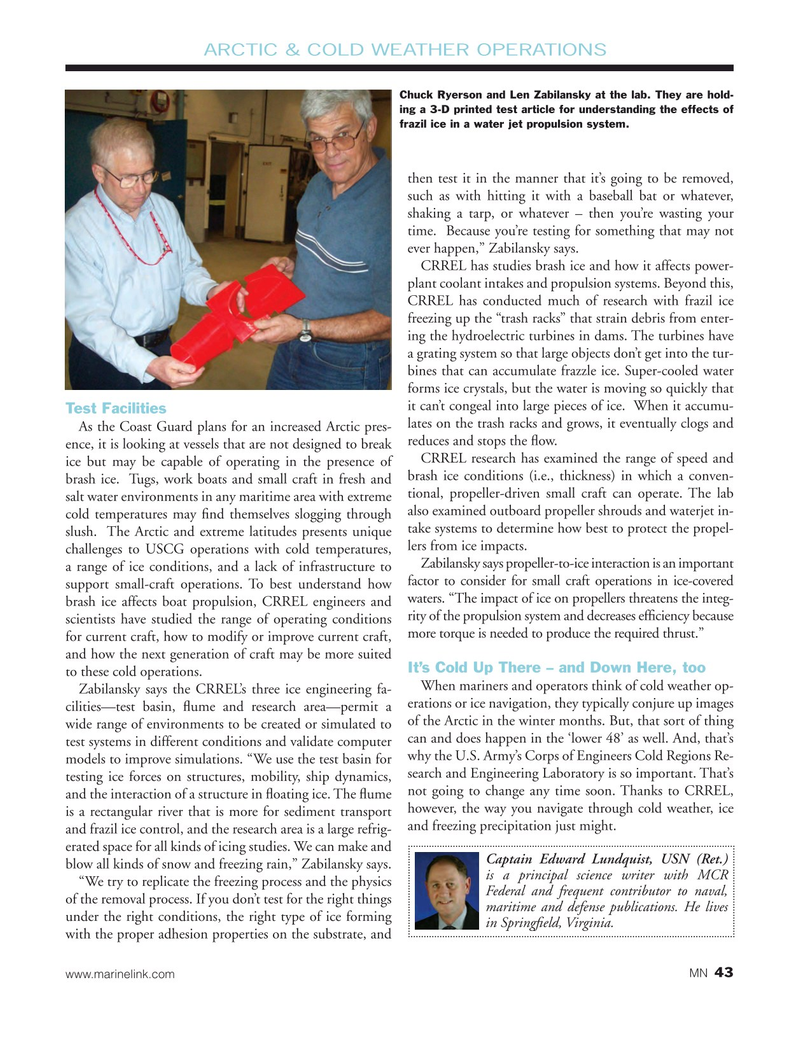
Page 43: of Marine News Magazine (January 2015)
Passenger Vessels & Ferries
Read this page in Pdf, Flash or Html5 edition of January 2015 Marine News Magazine
ARCTIC & COLD WEATHER OPERATIONS
Chuck Ryerson and Len Zabilansky at the lab. They are hold- ing a 3-D printed test article for understanding the effects of frazil ice in a water jet propulsion system.
then test it in the manner that it’s going to be removed, such as with hitting it with a baseball bat or whatever, shaking a tarp, or whatever – then you’re wasting your time. Because you’re testing for something that may not ever happen,” Zabilansky says.
CRREL has studies brash ice and how it affects power- plant coolant intakes and propulsion systems. Beyond this,
CRREL has conducted much of research with frazil ice freezing up the “trash racks” that strain debris from enter- ing the hydroelectric turbines in dams. The turbines have a grating system so that large objects don’t get into the tur- bines that can accumulate frazzle ice. Super-cooled water forms ice crystals, but the water is moving so quickly that it can’t congeal into large pieces of ice. When it accumu-
Test Facilities lates on the trash racks and grows, it eventually clogs and
As the Coast Guard plans for an increased Arctic pres- ence, it is looking at vessels that are not designed to break reduces and stops the ? ow.
CRREL research has examined the range of speed and ice but may be capable of operating in the presence of brash ice. Tugs, work boats and small craft in fresh and brash ice conditions (i.e., thickness) in which a conven- salt water environments in any maritime area with extreme tional, propeller-driven small craft can operate. The lab cold temperatures may ? nd themselves slogging through also examined outboard propeller shrouds and waterjet in- slush. The Arctic and extreme latitudes presents unique take systems to determine how best to protect the propel- challenges to USCG operations with cold temperatures, lers from ice impacts.
Zabilansky says propeller-to-ice interaction is an important a range of ice conditions, and a lack of infrastructure to support small-craft operations. To best understand how factor to consider for small craft operations in ice-covered brash ice affects boat propulsion, CRREL engineers and waters. “The impact of ice on propellers threatens the integ- scientists have studied the range of operating conditions rity of the propulsion system and decreases ef? ciency because for current craft, how to modify or improve current craft, more torque is needed to produce the required thrust.” and how the next generation of craft may be more suited
It’s Cold Up There – and Down Here, too to these cold operations.
When mariners and operators think of cold weather op-
Zabilansky says the CRREL’s three ice engineering fa- cilities—test basin, ? ume and research area—permit a erations or ice navigation, they typically conjure up images wide range of environments to be created or simulated to of the Arctic in the winter months. But, that sort of thing test systems in different conditions and validate computer can and does happen in the ‘lower 48’ as well. And, that’s models to improve simulations. “We use the test basin for why the U.S. Army’s Corps of Engineers Cold Regions Re- testing ice forces on structures, mobility, ship dynamics, search and Engineering Laboratory is so important. That’s and the interaction of a structure in ? oating ice. The ? ume not going to change any time soon. Thanks to CRREL, is a rectangular river that is more for sediment transport however, the way you navigate through cold weather, ice and freezing precipitation just might.
and frazil ice control, and the research area is a large refrig- erated space for all kinds of icing studies. We can make and
Captain Edward Lundquist, USN (Ret.) blow all kinds of snow and freezing rain,” Zabilansky says. is a principal science writer with MCR “We try to replicate the freezing process and the physics
Federal and frequent contributor to naval, of the removal process. If you don’t test for the right things maritime and defense publications. He lives under the right conditions, the right type of ice forming in Spring? eld, Virginia.
with the proper adhesion properties on the substrate, and 43 www.marinelink.com MN
MN Jan15 Layout 32-49.indd 43 MN Jan15 Layout 32-49.indd 43 12/22/2014 3:14:33 PM12/22/2014 3:14:33 PM

 42
42

 44
44
